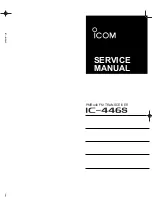
page 34
Owner’s Manual
GX1260S
PROBABLE
CAUSE
No DC voltage to the
transceiver, or blown
fuse.
Reversed power wires.
Engine noise.
External cable
Antenna.
T h e p o w e r s u p p l y
voltage is too high or
too low.
External cable.
S e t t i n g o f t h e G P S
navigation receiver.
REMEDY
Press and hold the Power switch/
V o l u m e c o n t r o l k n o b u n t i l t h e
transceiver turns on.
Check the power cable for DC voltage,
or replace the fuse (6A 250V).
Make sure the red wire is connected to
the positive battery post and the black
wire is connected to the negative. If
the fuse still blows, contact your SCC
Dealer.
Reroute the DC power cables away
f r o m t h e e n g i n e . A d d n o i s e
suppressor on power cable. Change
to resistive spark plug wires and/or
add an alternator whine filter.
Check the polarity of the connected
external cable.
Have the antenna checked or test the
transceiver with another antenna. If
the problem persists, contact your
SCC Dealer for servicing.
Confirm that the connected power
supply voltage is not 24 volts or lower
t h a n 9 v o l t s . C o n f i r m t h a t t h e
generator has not malfunctioned.
Check the polarity of the connected
external cable.
Check the output signal format of the
GPS navigation receiver. This radio
requires NMEA0183 format with GLL
sentence as an output signal.
SYMPTOM
T r a n s c e i v e r f a i l s t o
power up.
Transceiver blows fuse
w h e n c o n n e c t e d t o
power supply.
Popping or whining noise
from the speaker while
engine runs.
Sound is not emitted from
the external speaker.
Receiving stations report
low transmit power, even
with transceiver set to HI
power.
“HI BATTERY” or “LOW
BATTERY”is blinking
when the power is turned
on.
Y o u r p o s i t i o n i s n o t
displayed.
TROUBLESHOOTING CHART
9.2 TROUBLESHOOTING CHART
LO USA
HI BATTERY
A



































